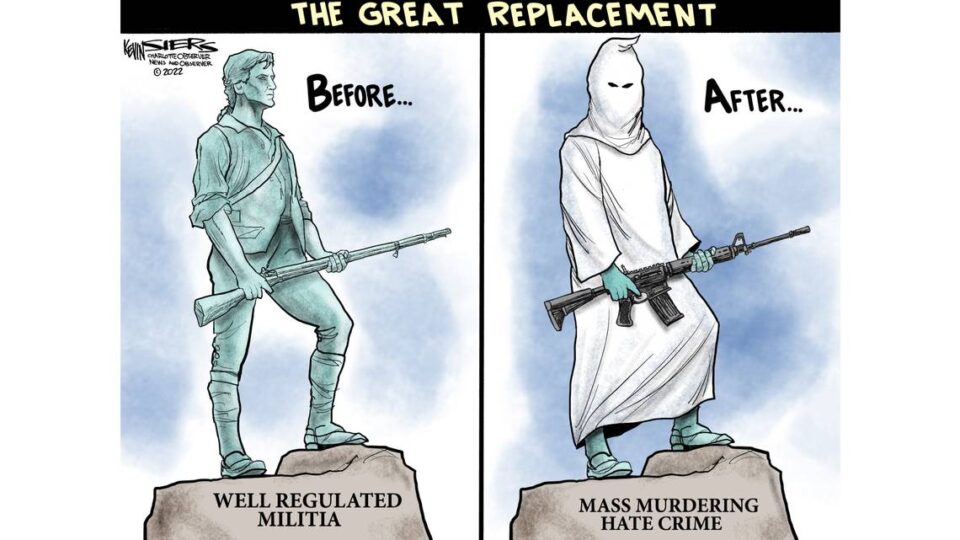Fox Host Now Calling Democrats ‘Anti-White’
Nearly 1,600 Registered as AAJA Conference Opens
Gannett Gradually Increasing Newsroom Diversity
Cabrera Is Sole Candidate for NAHJ President
How the Tuskegee Syphilis Story Broke
Sheila Rayam Is Buffalo News’ First Black Editor
Irving Washington Stepping Down as CEO of ONA
In Philly, Too, Pools Were No Respite From Racism
Roland Martin Counts 15-20 Million Views Monthly
Fleeing Mexico, Journalists Rebuild in Phoenix
Mable Haddock, Black Media Champion, Dies at 74
Short Takes: Ebony photo archives to be transferred; support for Black writers, animators, cartoonists in honor of Charles Shultz’ “Franklin” character; fired New Yorker editor charges racism; Terence Shepherd, Alison Bethel; reporters covering flood rescued; Portland, Ore., pays abused journalists; Pulitzer Prizes’ response to petition on Duke Ellington; first Latino to run AP’s Latin America and Caribbean region; Gannett translates Uvalde report for Spanish speakers;
Tanita Myers; Andrew Humphrey; three nonprofit news operations split 3.15 million; “Language Please” aids writers on sensitivities; Georgia Fort; Oklahoma Eagle collaboration with J-students; Leon Harris; podcast on Brazil and slavery inspired by ‘1619 Project’; Russian network sets up Africa bureau; Ghana failing on journalist freedom; Pakistani media aided on diversity; Congo rebel group beats, whips reporter.
Originally published July 28, 2022
Support Journal-isms(Click for Journal-isms fund-raising drive, underway on Facebook and GoFundMe)

Fox Host Now Calling Democrats ‘Anti-White’
Fox News host Tucker Carlson, with the highest rated show on cable news, said Tuesday, “So you see this massive disconnect where you have this party that is openly and very aggressively anti-white, the Democratic Party. And yet its leaders, including leaders of color like the Obamas, live in all-white neighborhoods. How long can that continue, I wonder?”
Two days earlier, according to Media Matters for America’s John Knefel, Carlson said in an interview “that society is oppressing and marginalizing white men, a once-controversial sentiment that has become standard fare for the most watched cable news host in the country.
“Carlson’s comments were reminiscent of remarks that conservative pundit Glenn Beck made in 2009 that triggered a wave of advertisers fleeing his Fox News show, and ultimately led to his firing in 2011.”
But now, the media watch organization said, “no one bats an eye.”
Last summer, Carlson famously hosted his program from Hungary and effusively praised its autocratic leader, Viktor Orban. On Saturday, Orban railed against Europe becoming a “mixed race” society, leading one of Orban’s advisers to resign Tuesday.
It’s time for the rest of the news media to arrest this cancer.
But how?
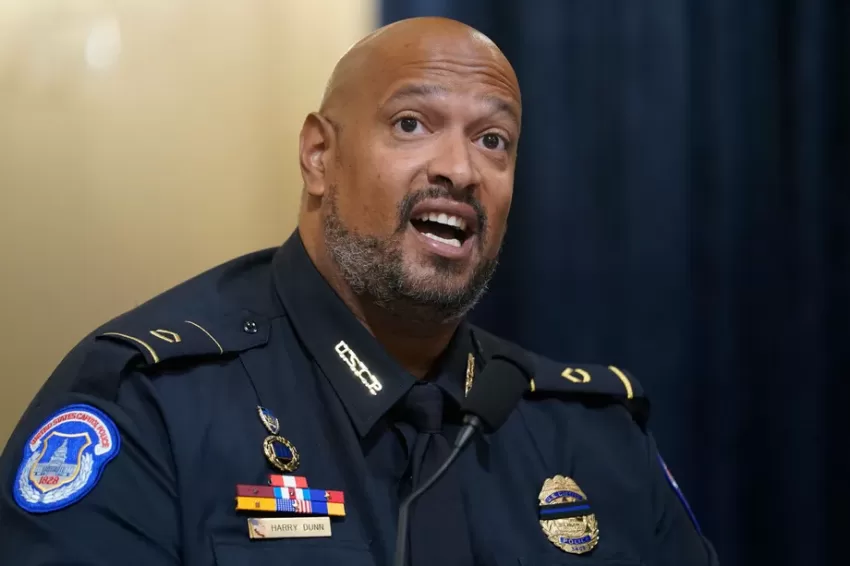
The nation saw the effects of the “white grievance” narrative in the Jan. 6 Capitol riot. “ ‘No one had ever ― ever ― called me a ‘n****r’ while wearing the uniform of a Capitol Police officer’ until that day, Officer Harry Dunn (pictured) told the Jan. 6 committee a year ago, in one of its early hearings.
Officer Aquilino Gonell of the Capitol Police, who immigrated from the Dominican Republic and is a naturalized U.S. citizen and veteran of the Iraq war, said that at different points during the insurrection, rioters told him “you’re not an American” — a conclusion Gonell said they reached solely because of his skin color.
And when Carlson touted the “great replacement” theory — that Democrats want to replace white American voters with more obedient people from the Third World — one of those listening was Payton Gendron, the white teen-ager accused in the mass shooting of Black shoppers in Buffalo, N.Y., that left 10 dead. That’s not to mention those with similar motives who undertook recent mass killings in Christchurch, New Zealand; El Paso, Texas; and at the Tree of Life in Pittsburgh.
It’s a narrative that some in the media have downplayed, according to Michael Feola, a law professor who is finishing a book manuscript on the far right’s politics of racial anxiety. Feola wrote in May for the Washington Post.
“Since the Buffalo attack, commentators and politicians from the right have attempted to divert attention from the theory and instead focus on the shooter’s shaky mental health. But ignoring this narrative would obscure how it feeds and amplifies networks of white extremist violence,” Feola wrote.
In late April, the Southern Poverty Law Center and Tulchin Research conducted a poll of 1,500 Americans to examine the extent to which the extremist beliefs and narratives that mobilize the hard right have been absorbed by the wider American public. They also measured the growing tolerance for political violence.
“We found that the ideas underpinning the white nationalist ‘great replacement’ narrative recently cited by an alleged white supremacist terrorist in Buffalo, New York, have become thoroughly mainstream on the political right,” the SPLC’s report said.
“Nearly 7 in 10 Republicans surveyed agree to at least some extent that demographic changes in the United States are deliberately driven by liberal and progressive politicians attempting to gain political power by ‘replacing more conservative white voters.’ Across the political spectrum, we found substantial support for threatening or acting violently against perceived political opponents. . . .”
Attempts to drive Carlson and like-minded bigots off the air by pressuring sponsors have failed. “If the goal was to change Fox News content it didn’t work,” media analyst Brad Adgate told Journal-isms. “Fox News continues to be a gold mine for the Murdochs so if there was an impact it was temporary. As for similar attempts,” It’s going to be difficult because Fox News is oftentimes the top rated cable network. Also in this polarized political world, marketers could be reluctant to alienate viewers.”
Moreover, Adgate noted, “Fox is still a big media company and [has] negotiating leverage with content distributors with broadcast stations and sports networks.”
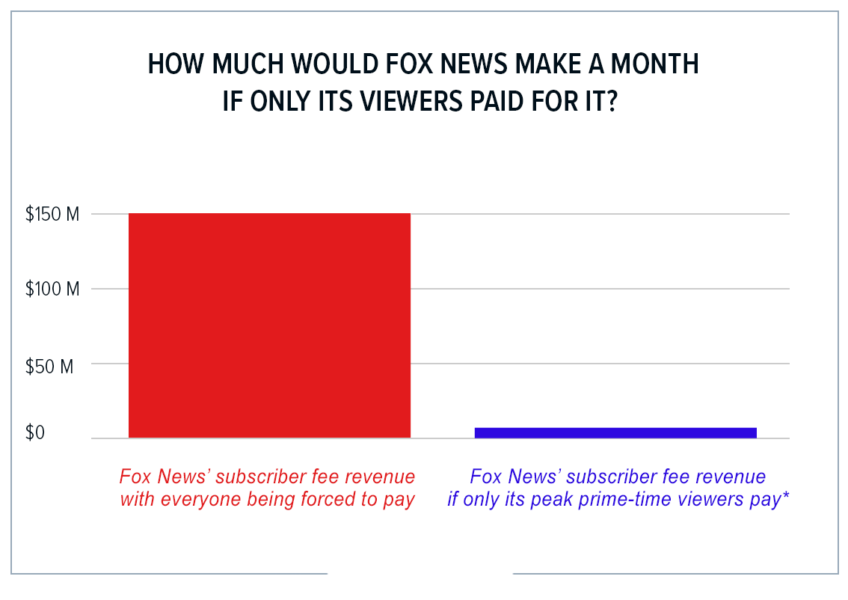
Still, Media Matters is reluctant to call its own targeting of sponsors a failure. The organization “still runs the DropFox initiative to hold Fox News accountable,” spokesperson Laura Keiter messaged. “That campaign includes both advertiser education efforts and also the UnFoxMyCableBox which seeks to educate the public about how Fox relies on artificially inflated cable fees more than it does advertisers since so many of their advertisers have fled.”
Public pressure on cable suppliers is starving the right-wing One America News Network of fees from such carriers as Verizon, Jeremy W. Peters and Benjamin Mullin reported Tuesday for The New York Times.
That gives comfort to Media Matters. “While cable companies may not drop Fox News, their interactions with OAN demonstrate that perhaps they are finally done with subsidizing content that is otherwise not commercially viable,” Keiter said. “This could be a point of leverage for the cable companies in driving down the subscription fee for Fox during future negotiations.”
 Clearly, journalists need to step up their game, too. “We must stop giving air to the contrived narrative that supporting civil rights or diversity and inclusion is a zero-sum game,” Michael D. Bolden (pictured), CEO and executive director of the American Press Institute, told Journal-isms. “Journalists must counter hyperbole with contextual truth in service to sincere civic dialogue and bolstering our democracy and the freedom and opportunity that it fosters for everyone.”
Clearly, journalists need to step up their game, too. “We must stop giving air to the contrived narrative that supporting civil rights or diversity and inclusion is a zero-sum game,” Michael D. Bolden (pictured), CEO and executive director of the American Press Institute, told Journal-isms. “Journalists must counter hyperbole with contextual truth in service to sincere civic dialogue and bolstering our democracy and the freedom and opportunity that it fosters for everyone.”
The New York Times’ Nicholas Confessore recently analyzed 1,150 episodes of “Tucker Carlson Tonight” and produced a series that began with “How Tucker Carlson Stoked White Fear to Conquer Cable.”
Media critics such as Margaret Sullivan and Erik Wemple of The Washington Post, and Lorraine Ali of the Los Angeles Times, all called out Carlson in connection with the Buffalo shooting.
Yet countering the “replacement” narrative, which in some form dates back centuries and today travels through Carlson to the darkest corners of the internet — has to go beyond the media critics, Susan Corke, director of the Southern Poverty Law Center’s Intelligence Project, told Journal-isms.
It means journalists checking themselves when they use different descriptions for Muslim terrorists than for white Christian ones, or ascribing more benign qualities, such as mental illness, to white shooters than to others.
“We need to pull back the curtain” on expressions of white supremacy, Corke said, wherever they lurk.
- Nicole Hemmer, New York Times: What Oprah Winfrey Knows About American History That Tucker Carlson Doesn’t (May 19)
- David Freedlander, New York magazine: Why Republicans Stopped Talking to the Press
- Charlotte Klein, Vanity Fair: Will Republicans Shut Out the Press in 2024?
- Jake Lahut, Business Insider: Fox News is going out of its way to defend Tucker Carlson as criticism grows over his promotion of white supremacist rhetoric (May 24)
- Dana Milbank, Washington Post: A hero of the Trump right shows his true colors: Whites only
- Clarence Page, Chicago Tribune: Don’t be duped by ‘replacement theory.’ Put race in its proper place (May 20)
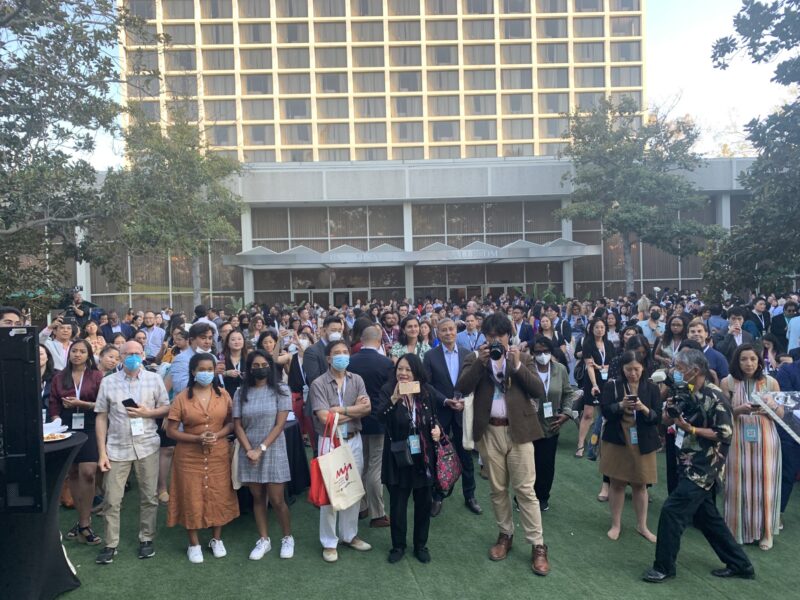
Asian American Journalists Association conference attendees gather outside the convention hotel, the Sheraton Universal Hotel in Universal City, Calif. (Credit: Anh Do/ Twitter)
Nearly 1,600 Registered as AAJA Conference Opens
By Henry Fuhrmann
The Asian American Journalists Association kicked off the summer run of diversity organizations’ national
conventions on Wednesday, welcoming the first several hundred of nearly 1,600 registrants.
AAJA — meeting in Los Angeles, the city of its founding in 1981 — said the number of expected attendees is the most for a convention in at least 15 years. The association had to cut off registration early, and eliminate on-site registration, just as the National Association of Black Journalists and the National Association of Hispanic Journalists have done for their joint national convention in Las Vegas next week.
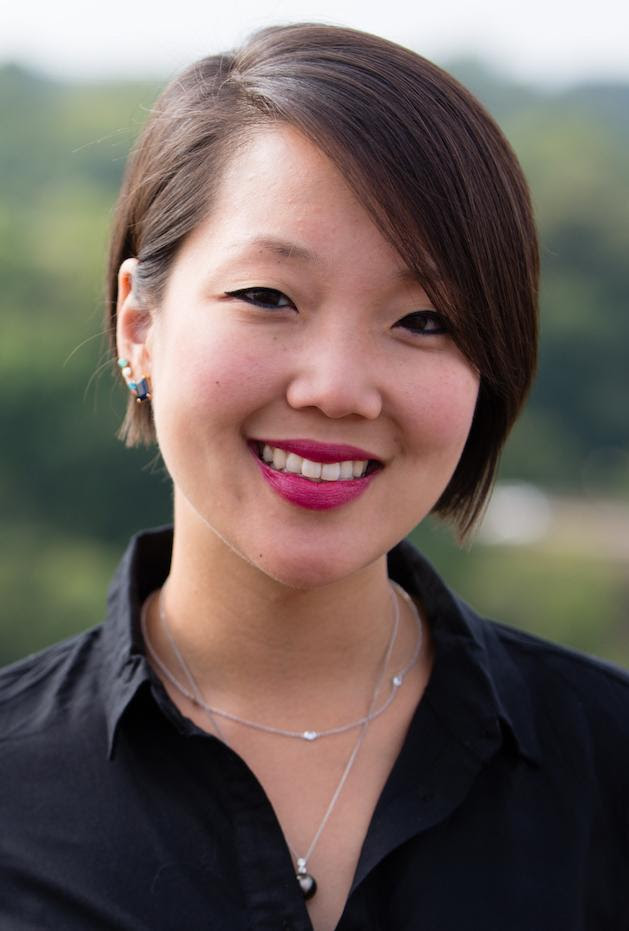 AAJA President Michelle Ye Hee Lee (pictured), Tokyo bureau chief for The Washington Post, welcomed convention-goers at an opening reception Wednesday at the Sheraton Universal Hotel in Universal City. The event was shifted outdoors in deference to the large attendance.
AAJA President Michelle Ye Hee Lee (pictured), Tokyo bureau chief for The Washington Post, welcomed convention-goers at an opening reception Wednesday at the Sheraton Universal Hotel in Universal City. The event was shifted outdoors in deference to the large attendance.
“This is the convention we wanted to do in 2020-2021,” Lee said, referring to the two virtual conventions made necessary by the pandemic.
The large attendance, she noted, coincides with the current healthy state of membership. AAJA surpassed 2,000 members in the last year, a level not seen since before the Great Recession.
AAJA convention-goers attributed this year’s huge response to pent-up demand for in-person interaction; the attraction of Los Angeles and the organization’s extended 40th-anniversary celebration; and, crucially, a fellow senior member said, a noticeable infusion of students and young professionals. In fact, the orientation session for first-time convention-goers filled the meeting room before moving outside to accommodate the crowd.
COVID-19 remains a concern, as Los Angeles County has been considering a new indoor mask mandate but as of Thursday had avoided one. AAJA is observing a mandatory mask policy for all indoor events.
Thursday morning’s plenary, “The Racism Virus: The Next Stage in the Fight Against AAPI Hate,” went smoothly, with the room of 260 seats nearly reaching but not exceeding capacity. The job and sponsor expo, with many news organizations actively hiring, had a steady flow of traffic Wednesday and through Thursday midday.
The convention runs through Saturday evening.
Henry Fuhrmann, a friend of Journal-isms, is a longtime AAJA member and leader of its Los Angeles chapter. He is a retired assistant managing editor at the Los Angeles Times.
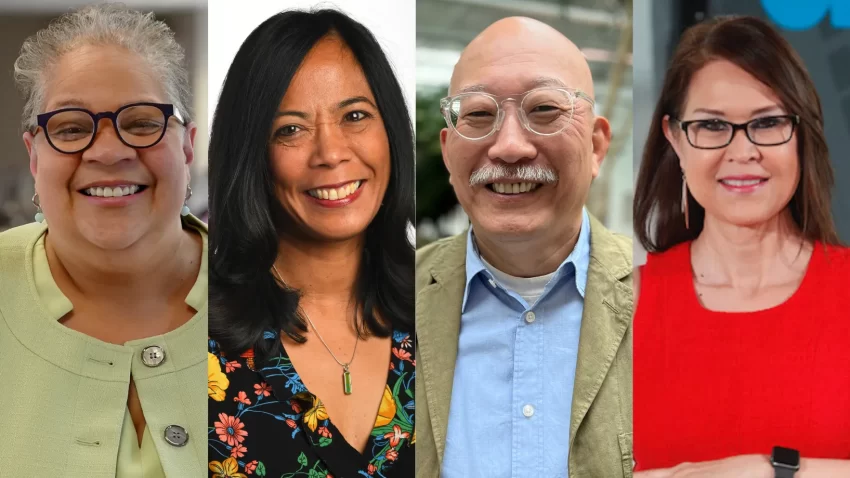
Clockwise, from top, left: Edwina Blackwell Clark, executive editor of the Columbus (Ohio) Dispatch; Roxanna Scott, executive editor of USA Today Sports; Aki Soga, top editor at the Burlington (Vt.) Free Press; Elva Diaz, opinion editor at the Arizona Republic. (Credit: USA Today)
Gannett Gradually Increasing Newsroom Diversity
In the wake of the racial reckoning that followed the police murder of George Floyd in 2020, Gannett pledged “to build a workforce that mirrors the demographics of the nation and the communities we serve by the end of 2025.” It also “committed to publicly report our staff demographics each year.”
On Wednesday, Nicole Carroll, editor-in-chief of USA Today and president of the Gannett news division, delivered the 2022 report, with diversity figures for USA Today and links to reports from 66 local news operations. She also gave examples of how staff diversity is playing out in the material that readers see.
“In Gannett’s content division, made up of more than 200 newsrooms nationwide, we showed continued positive progress in overall diversity, increasing in Black staffers (from 7.7% to 8.2%), Asian (from 3.5% to 3.9%), Hispanic/Latino (from 7.3% to 7.9%) and two or more races categories (1.6% to 2.2%), while holding steady in all others (Native American, 0.5%; Native Hawaiian/Pacific Islander 0.2%).
“Gender diversity showed a continued percentage increase in women, from 43.2% to 44.1%.
“However, in terms of leadership in the Gannett content division, gaps are wider. This underscores the continuing need to focus on retaining and recruiting the next generation of diverse newsroom leaders.
“Each of our local newsrooms has a goal to match its community. At USA TODAY, where we measure ourselves against the nation as a whole, 38% of our staff are people of color, with Black (15%), Asian American (7.8%), Native Hawaiian/Pacific Islander (.6%) and two or more races (3.4%), exceeding national parity. About 10% of our newsroom is Hispanic, while the nation is 19.9%. The USA TODAY newsroom is 54.8% women. . . .”
- Bob Sillick, Editor & Publisher: Francesca Chambers brings her passion for journalism to her new role as USA TODAY’s White House correspondent
Cabrera Is Sole Candidate for NAHJ President
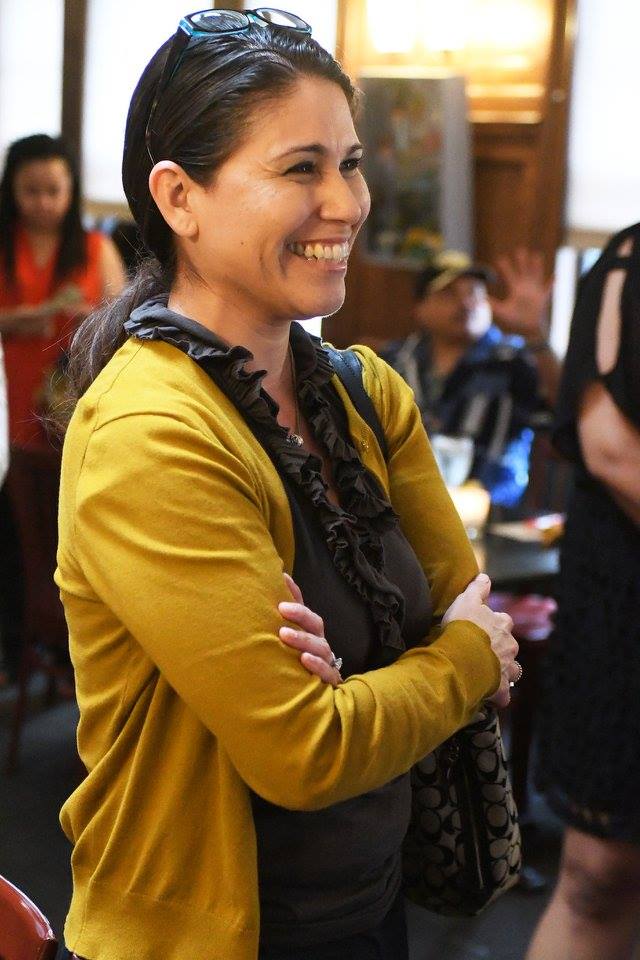 Yvette Cabrera (pictured), reporter at the Center for Public Integrity whose career has focused on environmental justice, a two-decade board member of CCNMA: Latino Journalists of California and current vice president/online of the National Association of Hispanic Journalists, is the sole candidate for NAHJ president. Voting began Saturday and continues until Saturday, Aug. 6, at 5 p.m. ET.
Yvette Cabrera (pictured), reporter at the Center for Public Integrity whose career has focused on environmental justice, a two-decade board member of CCNMA: Latino Journalists of California and current vice president/online of the National Association of Hispanic Journalists, is the sole candidate for NAHJ president. Voting began Saturday and continues until Saturday, Aug. 6, at 5 p.m. ET.
In her statement of candidacy, Cabrera said, “There is still much to do. This includes addressing NAHJ’s outdated bylaws, creating a Latina Leadership Institute, and strengthening the relationship between the national board and our chapter leaders. I pledge to implement our strategic plan as the guiding vision throughout my board term and will continue to advocate for our seat at the table while striving to achieve newsroom parity to ensure the voices of America’s Latinos are accurately reflected in our news coverage.”
Cabrera’s brief NAHJ biography notes that she “reports at the intersection of justice and equity, examining the impact of systemic disparities – such as environmental pollution and contamination – on marginalized communities throughout the country.” She “is the proud daughter of Mexican immigrants who taught her the importance of speaking up to address wrongdoing.” (Photo by Jason Miccolo Johnson, August 2017 Journal-isms Roundtable)
How the Tuskegee Syphilis Story Broke
“The story ran on July 25, 1972, a Tuesday. It was a harrowing tale,” Allen G. Breed reported Monday for the Associated Press, 50 years to the day after AP broke the shocking news, following up on documents a source provided in a thin manila envelope.
“Starting in 1932, the Public Health Service — working with the famed Tuskegee Institute — began recruiting Black men in Macon County, Alabama. Researchers told them they were to be treated for ‘bad blood,’ a catch-all term used to describe several ailments, including anemia, fatigue and syphilis. Treatment at the time consisted primarily of doses of arsenic and mercury.
“In exchange for their participation, the men would get free medical exams, free meals and burial insurance — provided the government was allowed to perform an autopsy.
“Eventually, more than 600 men were enrolled. What they were not told was that about a third would receive no treatment at all — even after penicillin became available in the 1940s.
“By the time [Jean] Heller’s story was published, at least seven of the men in the study had died as a direct result of the affliction, and another 154 from heart disease.”
The experiment left Black people suspicious of government-involved health care, persisting to this day. “Tuskegee is the one-word answer some people give as a reason they’re avoiding COVID-19 vaccines,” Lindsay Tanner wrote for the AP a year ago. “A new ad campaign launched . . . with relatives of men who unwittingly became part of the infamous experiment wants to change minds.”
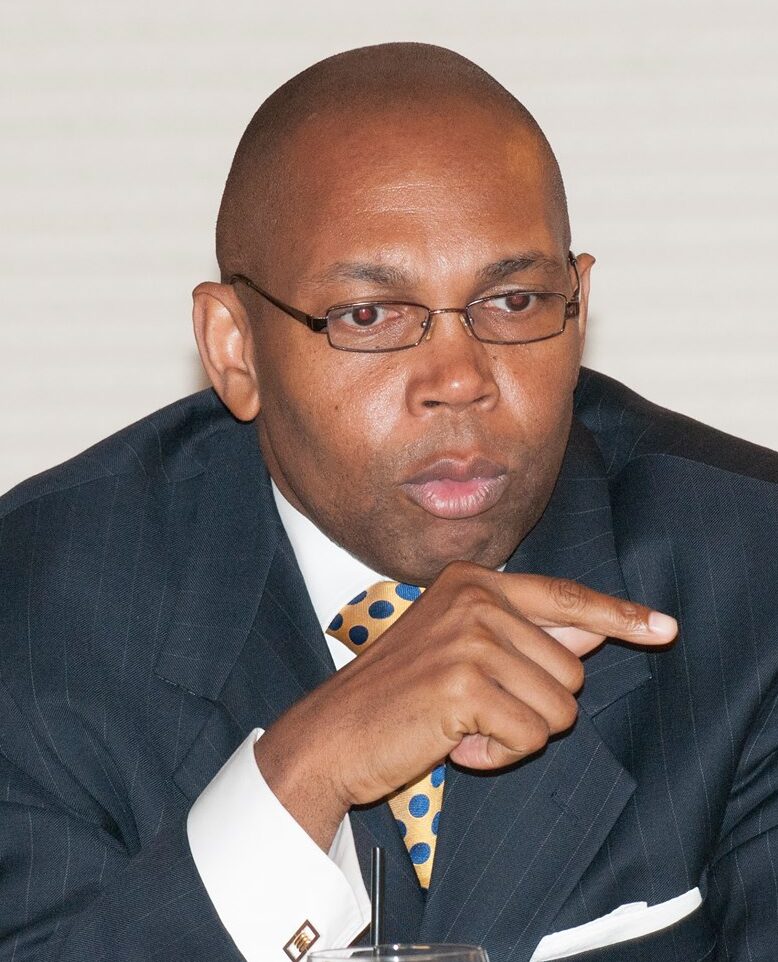 The “how-we-got-that-story” project was the idea of Ron Nixon (pictured), who became the AP’s global investigations editor in March 2020, overseeing teams of reporters around the world.
The “how-we-got-that-story” project was the idea of Ron Nixon (pictured), who became the AP’s global investigations editor in March 2020, overseeing teams of reporters around the world.
“Since it took over the team, I’ve been trying to chronicle its history,” Nixon messaged Journal-isms. “I didn’t realize it went back as far as it did,” to 1967.
“I reached out to Jean and Austin Scott, the only original team members who are alive as far as I can tell. . . . So I’ve been talking to Jean for over a year and even had her come to one of our virtual team meetings. We have an internal fellowship for reporters called the Jean Heller Fellowship for Investigative Reporting that I started. Originally, I was just going to republish the original story with a video and leave it at that. But Jean gave Allen Breed the reporter all this great detail so I decided to do a separate story behind the story. . . .”
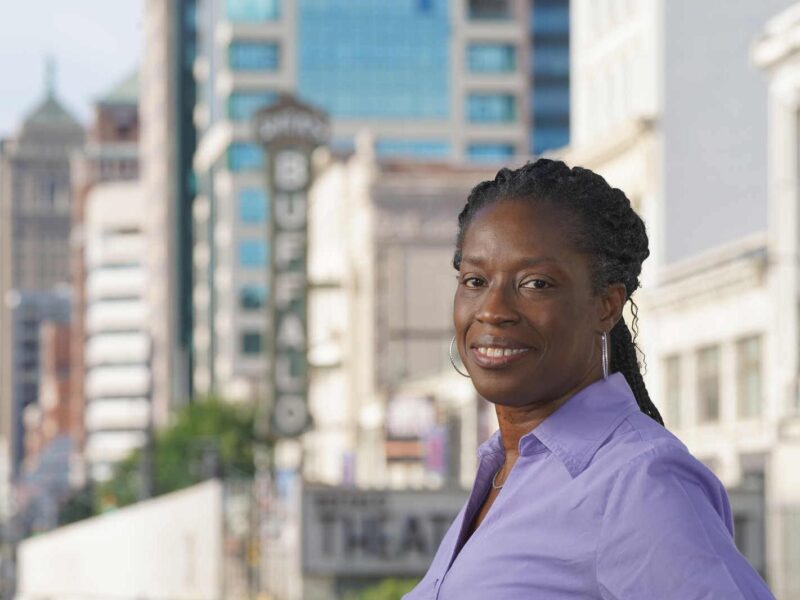
Sheila Rayam, incoming editor of the Buffalo News, said, “The thought of being in a city that I love and working and leading a team that I respect a great deal was just an opportunity that I couldn’t pass up.” (Credit: Derek Gee/Buffalo News)
Sheila Rayam Is Buffalo News’ First Black Editor
“Longtime journalist Sheila Rayam has been named executive editor of The Buffalo News, the first Black journalist and the second woman to hold the position in The News’ 142-year history,” Jon Harris reported Tuesday for the News.
“Rayam has been the executive editor of Gannett’s Mohawk Valley news operations, including the Utica Observer-Dispatch, since April 2021. Prior to that, she spent three decades rising through the ranks at the Democrat & Chronicle [in Rochester] after graduating from SUNY Buffalo State. Rayam, a Rochester native, is scheduled to start her new role in Buffalo on Aug. 22.
“Rayam, 55, will be the newspaper’s eighth editor, succeeding news industry veteran Mike Connelly, who retired May 6 after nearly 10 years in the job. His retirement led to a national search for a successor, culminating Tuesday when President and Publisher Tom Wiley announced Rayam’s appointment. . . .
“ ‘There are many more stories to tell,’ she said. ‘I think The Buffalo News will be key in really unraveling this tragedy and helping the community move forward as best we can.’ “
Harris also wrote, “Rayam takes the job as The News continues to cover the aftermath of the mass shooting on May 14 at the Tops Markets store on Jefferson Avenue, where a racist gunman from the Binghamton area killed 10 Black people and wounded three others in a massacre that rattled the community and the country.
“Reading from afar, Rayam said she was struck by The News’ thoughtful coverage, in which she observed reporters trying to connect with the community and make readers understand the tragedy’s devastating impact.”
In addition, “Rayam said she’s eager to engage with the community when she arrives in Buffalo. That will be one of her major priorities and one in which she will lean on her experience as the Democrat & Chronicle’s community engagement editor from December 2014 to March 2021. . . .”
” We are proud to have Sheila as the eighth editor of The Buffalo News,” Wiley said. ‘”Her intelligence, warmth and integrity combined with her passion for journalism will help lead our organization into an exciting future. She brings an impressive history of innovative, audience-focused journalism leadership to The Buffalo News.”
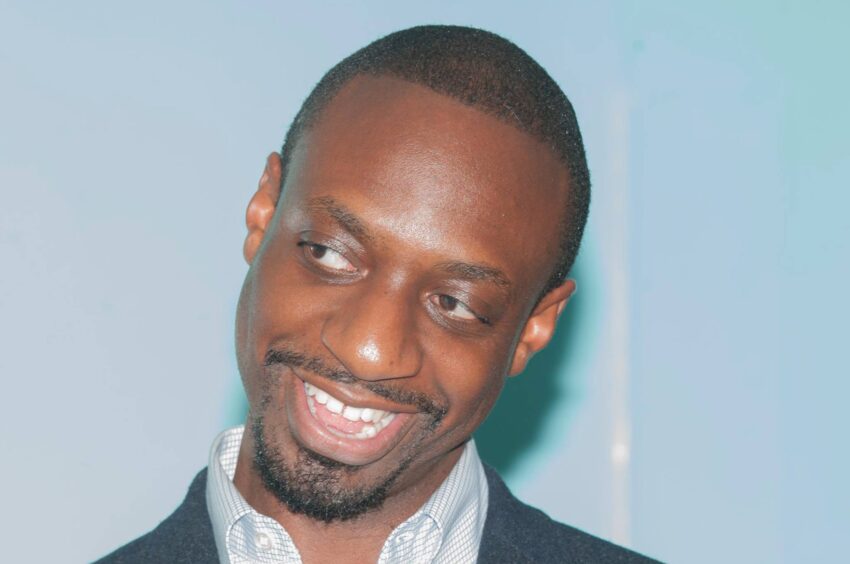
“What drives me is a desire to protect and support our access to information, and to ensure that individuals from diverse backgrounds have leadership opportunities within journalism and media-related industries,” Irving Washington said. He appeared in September 2018 at the Journal-isms Roundtable. “It feels good to wake up each day and be surrounded by colleagues who are serious about advancing diversity.” (Credit: George Dalton Tolbert IV/Tolbert and Bing Studios)
Irving Washington Stepping Down as CEO of ONA
Irving Washington, CEO of the Online News Association since 2017, is stepping down at the end of the year, he announced this week, then will “take some time during this transition to explore what the next season holds for me.”
ONA describes itself as the world’s largest organization of digital journalists. Washington joined the management team in 2011. When he was named CEO, the organization said he had managed ONA’s highest-profile initiatives, was point person for all logistics for ONA’s annual conference and grew the organization’s critical diversity and professional development programs.
Before that, he spent six years with the National Association of Black Journalists, where Washington was program manager, and two with the Radio Television Digital News Association, where he was diversity and education coordinator.
In 2019, when he was 39, the Washington Business Journal named Washington one of its “40 Under 40” ‘– “young men and women whose accomplishments in just a few decades make them stand tall in their peer groups.” The Journal said, “Print journalism isn’t dead, but its peak has passed — the future is online, and Irving Washington is partially driving that movement.”
On Tuesday, Board President David Smydra wrote, “Under Irving’s leadership, ONA has doubled its staff, grown a multimillion-dollar budget and dramatically deepened its investment in programs that champion innovation, skill-building, mentorship and collaboration. During the turbulence of the pandemic, Irving’s stewardship kept ONA strategically on course, enabling our community to endure, connect and thrive in the most uncertain of times.
“Moreover, Irving supercharged ONA’s commitment to diversity, equity and inclusion. From the Women’s Leadership Accelerator to support of The Pivot Fund, you can feel this animating spirit throughout all of ONA’s programs. For this reason, I believe that Irving’s legacy isn’t simply that ONA helped make journalists and newsrooms more successful — it’s that ONA, under his leadership, made them better.”

In 2004, Philadelphia Mayor John Street said the city would have to sell or close the Athletic Rec Pool in the changing Brewerytown neighborhood, part of an effort to balance the budget. “Nineteen other pools were also on the chopping block. Across every neighborhood, residents fought back. A nonprofit sued the city, arguing that the closures discriminated against Black and Latino residents, who would be disproportionately harmed. (The lawsuit was dismissed). Outside of Mayor Street’s news conference one afternoon, two dozen West Philadelphia kids chanted ‘We want to swim!’ so loudly they briefly drowned out the mayor.” (Painting by Serena Saunders)
In Philly, Too, Pools Were No Respite From Racism
“Philadelphia once had a radical vision for its public pools, opening America’s first outdoor public pool in 1883,” the Philadelphia Inquirer said in advertising “Ghosts in the Water,” the latest in its continuing series on race. “Yet racism has never been far from the surface, shaping the system and contributing to the crisis that puts it in peril today.
“In the latest installment of A More Perfect Union – our year-long series examining the Philadelphia roots of systemic racism in America – reporter Zoe Greenberg dives into the archives to tell the story of one community’s struggle to offer Black swimmers equal access to one of summer’s greatest joys.
“She brings us inside a North Philadelphia pool shaped by a little-known race riot and shares the story of the people who have kept it alive in the face of deadly challenges.”
Greenberg’s story makes another point:
“Twenty of the city’s 70 outdoor pools won’t open at all this year because of repairs and staff shortages. Twenty-four opened the week of July 4, halfway through the summer.
“Residents and public officials connect the shuttered pools to the city’s gun crisis, an epidemic that tends to spike along with the temperature. District Attorney Larry Krasner recently said extending pool hours would be a way of ‘saving lives.’ Community activist Kirsten Britt protested pool closures last year by placing a coffin at the center of a demonstration.
“ ‘It’s not just a swimming pool, ‘ said City Councilmember Jamie Gauthier, vice chair of Council’s Committee on Parks, Recreation, and Cultural Affairs. ‘The more we allow for these recreational assets to sit disinvested, the more young people that are going to die because they don’t have positive outlets, and safe, fun things to do.’ . . .”
Greenberg also writes, “Philadelphia was once the pool capital of the nation, even building the first outdoor city pool in 1884. The city helped to advance a radical vision that others soon adopted: To build good citizens, invest in public space. Those early pools were imperfect public squares, initially unsegregated by race.”
But though Philadelphia is a Northern city, its pools became segregated by race. The reader is taken to 1941: “Much of the upheaval at city pools at the time was rooted in the unspoken fear that Black men would interact with white women in ‘such intimate and erotic public spaces,’ wrote Jeff Wiltse, a historian whose research is currently featured in the ‘POOL’ exhibit at the Fairmount Water Works.
“To make sure that didn’t happen, local white men in Philadelphia policed the pools themselves, often with brutality, said Victoria Wolcott, author of the book Race, Riots, and Roller Coasters: The Struggle Over Segregated Recreation in America. If pools were joyful places for white Philadelphians, they would be kept off-limits to their Black neighbors.
“In the days that followed the ‘full-sized race riot,’ as The Inquirer called it, city leaders struggled to make sense of what had happened. Black leaders saw the turmoil as the somewhat predictable result of City Council ignoring their pleas for more recreation spaces. . . .”
Roland Martin covered the opening of the Jackie Robinson Museum Tuesday in Lower Manhattan. “It’s a homage to Robinson’s multi-faceted existence, featuring 350 artifacts with an emphasis on his Civil Rights work,” the Daily News in New York wrote.
Roland Martin Counts 15-20 Million Views Monthly
“Roland Martin believes in Black-owned media, and he’s using his own money to prove it,” reads the headline Monday over a profile by Stephen Battaglio of the Los Angeles Times.
The reference is to Martin’s next steps after TV One canceled his daily newscast, “NewsOne Now,” in 2017.
“By that time, Martin, a student of the technical side of TV, realized how streaming video offered the opportunity for ownership, editorial freedom and the ability to target an audience seeking his perspective. Using his own funds ($400,000 was the initial investment), Martin created ‘#RolandMartinUnfiltered,’ a daily two-hour show distributed through an app, social media sites and streaming video platforms such as Roku, Fire TV and Apple TV. Today, he has nearly 900,000 subscribers on YouTube, where the show first launched, and 11 employees.
“Martin knew his fan base would respond. In the small lobby of the 5,000-square-foot office space he converted into a studio, there are oil paintings and sketches created by devoted viewers of his TV One programs.
“Martin’s voice was welcomed as major stories such as the police murder of George Floyd and the impact of the COVID-19 pandemic made race and equity issues a major national conversation. In 2020, his program averaged 30 million views a month and turned a profit, he said. Like all other news platforms, its viewership ebbed in 2021, but he says his channel is still drawing between 15 million to 20 million views a month. . . .”
Battaglio also wrote, “Despite the challenges, Martin is determined to keep Black Star Network free for its users. He believes many of his followers could not afford the cost of a monthly subscription for his programs. He supplements his ad revenue by soliciting contributions through fan club memberships and has amassed 35,000 since he launched.
“While most donors use online payments, Martin stops by a post office box and picks up mailed-in contributions as well. During a recent visit to his office, he pulled a stash of checks and money orders and a wad of bills out of his overstuffed backpack.
“Martin’s eyes fill with tears as he recounts how fans come up to him at appearances and remote broadcasts with cash in hand. He shows a dollar bill folded into an origami heart, given to him by a wheelchair-bound elderly woman he encountered at an airport in Atlanta. . . .”
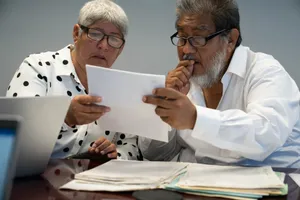
María de Jesús Peters, left, and García Davish (Credit: Arizona Republic)
Fleeing Mexico, Journalists Rebuild in Phoenix
“Due to the increased violence in Mexico against journalists and the lack of protection provided by the government, García Davish and his wife, María de Jesús Peters, also a journalist in Chiapas, made the difficult decision to leave their lifelong home,” Javier Arce and Joanna Jacobo Rivera wrote Monday for the Arizona Republic. Arce is a reporter and editor for La Voz Arizona, the Republic’s sister publication.
“Since June, they’ve been trying to rebuild their life in Phoenix, figuring out how to navigate a new country and calling for international governments to intervene and better protect Mexican journalists. . . .
“According to the organization Article 19, a freedom of the press advocacy organization in Mexico and Latin America, Mexico is experiencing one of the most violent presidencies against Mexican journalists. So far in 2022, 10 people have officially been killed in connection with their work as journalists — unofficially, 12 have been murdered.”
The reporters also wrote, “Peters and García Davish have been in the U.S. for less than a month and much of their time in Phoenix has been used to shed light on the issue, calling for the Biden administration to intervene in order to cease the violence against journalists in Mexico.”
“According to Noemí Pineda, researcher of documentation and case follow-up of Article 19, from 2018 to 2021, the organization has registered a total of 21 cases of displaced journalists due to violence against the press in Mexico. But this number is higher, she said, given that not all journalists under threat let them know they are seeking refuge elsewhere. . . .’
Mexico is only one country in Latin America where journalists are endangered On July 21, Gabriela Selser reported for the Associated Press from Mexico City, “One of Nicaragua’s leading national newspapers announced Thursday on its website that its staff had been forced to flee the country and would continue working from outside Nicaragua.
“Nicaraguan authorities took control of La Prensa’s offices in August and arrested two of its employees earlier this month. Those arrests came after La Prensa reported on the expulsion [of] nuns from the Missionaries of Charity established by Mother Teresa. . . .
- Rachel Garbus, Atlanta magazine: As MundoNow, Georgia’s largest Spanish-language media company is reaching out to a bilingual, bicultural audience (July 8)
- Júlio Lubianco, LatAm Journalism Review: More journalists murdered in Latin America in last six months than in all of 2021: PEC (July 12)
- Radio Television Marti via LatAm Journalism Review: Cuba: Independent journalist abandons profession due to State Security pressure
- Fernando Soto, Nuestro Estado via Better News: How Nuestro Estado built a Spanish-speaking audience in South Carolina
- Maria Verza, Associated Press: Mexican journalist complains to president of threats (July 20)
Mable Haddock, Black Media Champion, Dies at 74
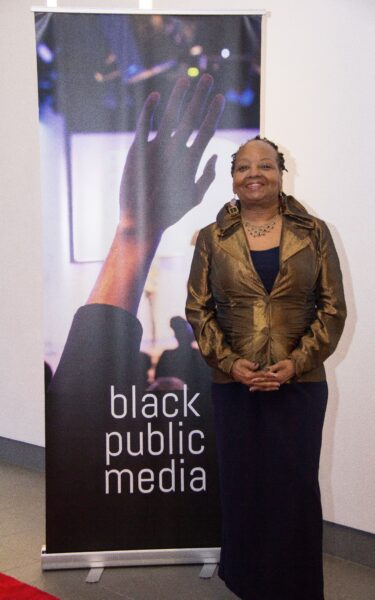
Mable Haddock (pictured), pioneering public media figure and champion of Black television and film, has died, [PDF],” Black Public Media announced Wednesday.
“The founding president and first CEO of the National Black Programming Consortium (NBPC) — now Black Public Media (BPM) — died on Saturday, July 23, 2022, in New York City at the age of 74 of kidney disease after a brief hospitalization. BPM is the Harlem-based national media arts nonprofit dedicated to creating and producing media content about the Black experience.
“ ‘Mable exemplified what it meant to be authentically Black and female in a professional space. She wasn’t afraid to speak truth to power, both verbally and in her writings,’ said BPM Executive Director Leslie Fields-Cruz. ‘A true trailblazer, she was a warrior in the fight for equity in public media, and a friend to all.’
“Haddock dedicated her life to bringing diverse voices to public media and beyond. In 1979, she helped found NBPC in Columbus, Ohio, to support Black stories and storytellers in film and television, helming the nonprofit for a quarter of a century and overseeing its transition to its eventual home in Harlem.
“During her tenure, more than $6 million in funding was dispersed to hundreds of film and television producers, and scores of documentaries and programs were aired on public television through series she produced, including Matters of Race, Unnatural Causes, Mandela, The Fannie Lou Hamer Story, The State of Black America (I and II) and other programs. Under her leadership, the organization joined forces with other like-minded organizations, forming the National Minority Consortia — now the National Multicultural Alliance, which continues to bring increasingly diverse content and talent to public media. . . .” (Photo credit: Black Public Media)
-
- Etan Vlessing, Hollywood Reporter, Mable Haddock, Black Public Media Founder, Dies at 74
Short Takes
-
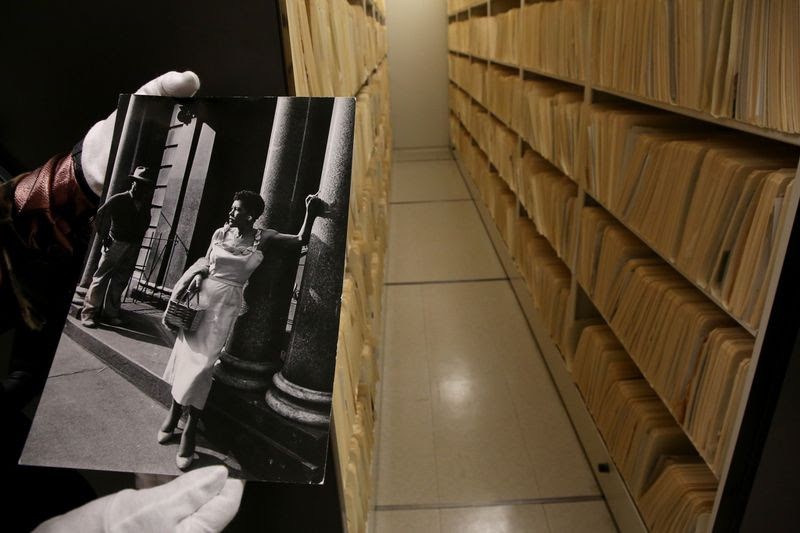
A photo of Billie Holiday is part of the Ebony archives. (Credit: Nancy Stone/Chicago Tribune)
- “A consortium comprising the Ford Foundation, the J. Paul Getty Trust, the John D. and Catherine T. MacArthur Foundation, the Mellon Foundation, and the Smithsonian Institution, announced today the official transfer of ownership of the acclaimed Johnson Publishing Company (JPC) archive to the Smithsonian National Museum of African American History and Culture (NMAAHC) and to the Getty Research Institute, a program of the Getty Trust,” the Ford Foundation announced Thursday. “The Getty Trust has committed $30 million in support for the processing and digitization of the archive — an essential step in the critical work of making this preeminent collection available and searchable to scholars, researchers, journalists, and the general public. With work already underway, portions of the archive will be accessible to the public during the ongoing intensive digitization process. . . .”
 “In 1968, Charles M. Schulz introduced the first Black character to his famous comic strip; Franklin (pictured) joined Charlie Brown, Snoopy and the rest of the Peanuts gang . . .,” Mandalit del Barco reported Thursday for NPR. “Now, more than half a century later, Peanuts Worldwide has created The Armstrong Project in his honor to support up-and-coming Black writers, animators and cartoonists.” Armstrong refers to cartoonist Robb Armstrong of “Jump Start.” “With the Armstrong Project, he’ll provide internships and guidance to students. He said he’ll remind them that cartooning ‘is not the same as doodling in math class.’ The Armstrong Project also has a $200,000 endowment to give scholarships for students at historically Black colleges. . . . According to the Census and the Bureau of Labor Statistics, fewer than 4% of animators are African American. . . .”
“In 1968, Charles M. Schulz introduced the first Black character to his famous comic strip; Franklin (pictured) joined Charlie Brown, Snoopy and the rest of the Peanuts gang . . .,” Mandalit del Barco reported Thursday for NPR. “Now, more than half a century later, Peanuts Worldwide has created The Armstrong Project in his honor to support up-and-coming Black writers, animators and cartoonists.” Armstrong refers to cartoonist Robb Armstrong of “Jump Start.” “With the Armstrong Project, he’ll provide internships and guidance to students. He said he’ll remind them that cartooning ‘is not the same as doodling in math class.’ The Armstrong Project also has a $200,000 endowment to give scholarships for students at historically Black colleges. . . . According to the Census and the Bureau of Labor Statistics, fewer than 4% of animators are African American. . . .”
- Erin Overbey, archives editor at The New Yorker, “who says she was ‘shocked’ when she was fired on Friday, claimed she’d been in multiple discussions with colleagues about the lack of Black editors on The New Yorker’s masthead,” Lachlan Cartwright wrote Monday for The Daily Beast. “ ‘This is specifically about the lack of diversity and the lack of pay equality at the magazine,’ Overbey, who is white, told us.” A Conde Nast spokesperson replied, “The New Yorker prides itself on professionalism, accuracy, and adherence to the highest journalistic standards. False allegations that malign our journalistic integrity and that attack colleagues are inappropriate and unacceptable in our workplace.” The spokesperson also pointed to a statement from September, “We’ve worked hard for years to increase the number of underrepresented voices at The New Yorker, and we’ve made significant progress — among our writers, in senior editorial positions, and across the entire enterprise. Nearly 40% of new hires at Condé Nast are from diverse and underrepresented backgrounds. While we don’t believe these tweets present a full or fair view of The New Yorker and its ongoing efforts, there is always more work to do, and we look forward to doing it.”
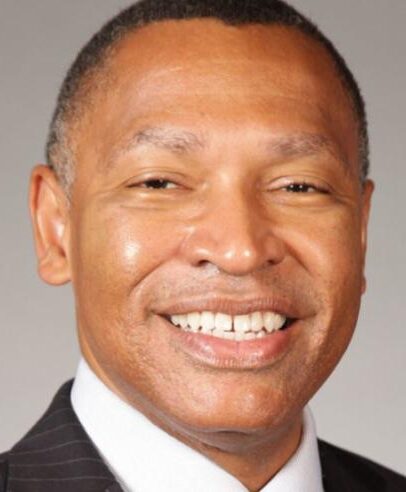 “Terence Shepherd (pictured) has been named News Director for KPBS, San Diego’s NPR and PBS public media station. He will oversee a department of 45 editors and journalists. He will join the station on August 8,” the station announced Monday. “Shepherd comes to KPBS from WLRN News, the public radio news outlet serving Broward, Miami-Dade, Palm Beach and Monroe counties [in Florida], where he has been news director since 2013.” Shepherd is a past chairman of the Radio Television Digital News Association, the first Black person to hold that position; former president of the South Florida Association of Black Journalists; and 14-year business reporter for the Miami Herald.
“Terence Shepherd (pictured) has been named News Director for KPBS, San Diego’s NPR and PBS public media station. He will oversee a department of 45 editors and journalists. He will join the station on August 8,” the station announced Monday. “Shepherd comes to KPBS from WLRN News, the public radio news outlet serving Broward, Miami-Dade, Palm Beach and Monroe counties [in Florida], where he has been news director since 2013.” Shepherd is a past chairman of the Radio Television Digital News Association, the first Black person to hold that position; former president of the South Florida Association of Black Journalists; and 14-year business reporter for the Miami Herald. Alison Bethel (pictured) has joined State Affairs, an independent news website headquartered in New York, as its first editor in chief. A veteran journalist, Bethel was vice president of corps excellence at Report for America, a non-profit initiative of The GroundTruth Project, which places emerging journalists in newsrooms across the country, including Hawaii and Alaska, as well as in Puerto Rico and Guam, to cover untold stories and communities, an announcement said. State Affairs, founded in 2021, is a “non-partisan, subscription-based news outlet” that “focuses on stories that report the impact state legislation, policy and political figures have on citizens’ everyday lives.” (Photo by Sharon Farmer/sfphotoworks)
Alison Bethel (pictured) has joined State Affairs, an independent news website headquartered in New York, as its first editor in chief. A veteran journalist, Bethel was vice president of corps excellence at Report for America, a non-profit initiative of The GroundTruth Project, which places emerging journalists in newsrooms across the country, including Hawaii and Alaska, as well as in Puerto Rico and Guam, to cover untold stories and communities, an announcement said. State Affairs, founded in 2021, is a “non-partisan, subscription-based news outlet” that “focuses on stories that report the impact state legislation, policy and political figures have on citizens’ everyday lives.” (Photo by Sharon Farmer/sfphotoworks)
-
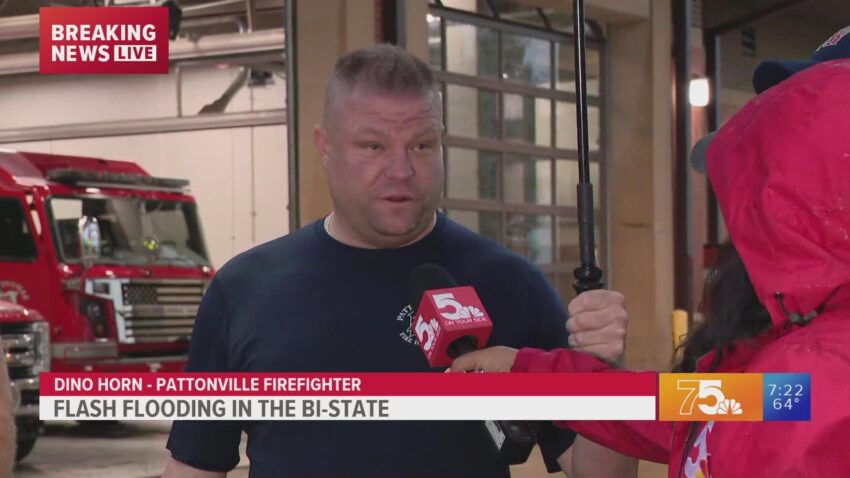
- “I was extremely scared for myself and for Mercedes,” reporter Sidney Stallworth of KDKA-TV in St. Louis said of herself and her colleague Mercedes Mackay. They were covering extreme flooding in the St. Louis suburbs when their car was overtaken by flood waters. The Pattonville (Mo.) Fire Department rushed to the rescue – “all in a day’s work in this time of extraordinary flooding in the region,” as the NewsBlues website put it. “Stallworth took to Twitter to express the pair’s thanks. She then proceeded to do her job – interview her rescuers,” NewsBlues said. During Tuesday’s downpour, “the city’s central corridor and northwest side were drenched as interstates closed, businesses flooded and dozens of people needed rescuing from vehicles,” the St Louis Post-Dispatch reported. (Credit YouTube)
- “The city of Portland has paid $55,000 to two independent journalists who alleged excessive force by Portland police during a 2020 Black Lives Matter demonstration,” the Associated Press reported July 20 from Portland, Ore. “Cory Elia and Lesley McLam were contributing to Village Portland and KBOO Community Radio when they were arrested while live-streaming a protest. After police deployed tear gas into the crowd, Elia was forced to the ground by at least four officers and McLam, who was trying to take Elias’ phone and press pass for him, was tackled by police,” according to a lawsuit. “Portland paid $335,000 in 2021 to settle protest-related lawsuits involving police, according to city records.”
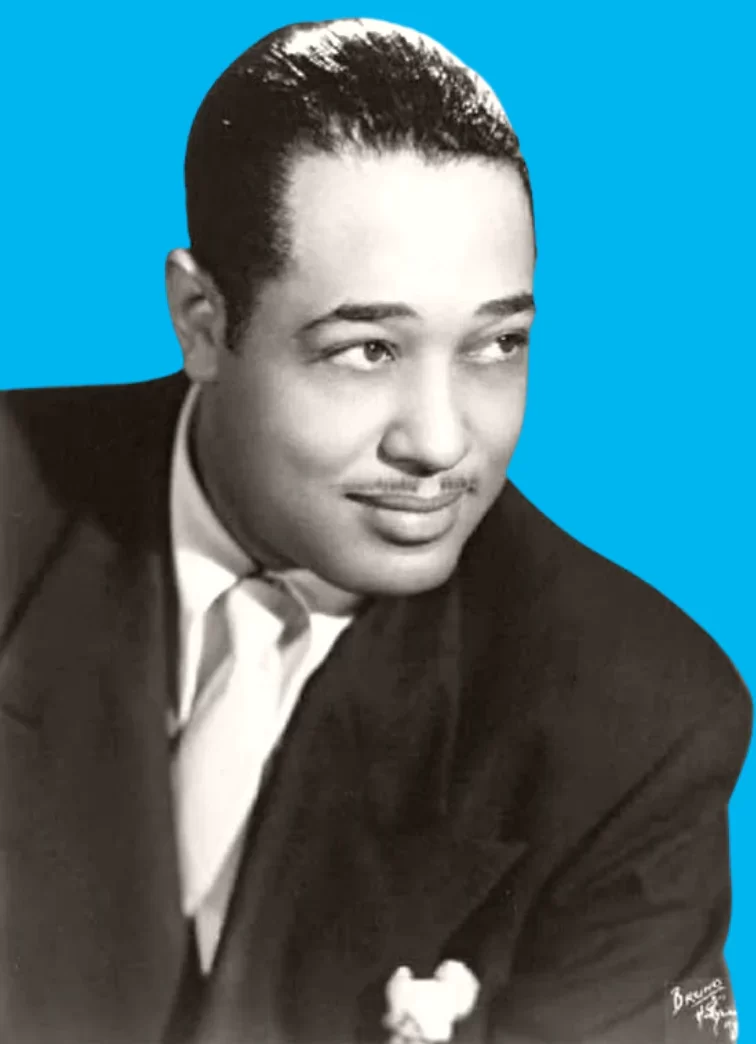 Marjorie Miller, administrator of the Pulitzer Prizes, responded in The New York Times Thursday to a petition started by jazz scholar Ted Gioia and endorsed by Columbia University linguist John McWhorter urging that Duke Ellington (pictured) be posthumously awarded the 1965 Pulitzer Prize in Music that he was denied then. Miller replied, “In 1999, the Pulitzer Board finally awarded a special Pulitzer citation to Ellington on the occasion of his centennial year (scroll down). “The award expressly honored Ellington’s ‘indelible contribution to art and culture’ and implicitly redressed a grave wrong. We believe that special citations are as consequential as our other awards. . . .”
Marjorie Miller, administrator of the Pulitzer Prizes, responded in The New York Times Thursday to a petition started by jazz scholar Ted Gioia and endorsed by Columbia University linguist John McWhorter urging that Duke Ellington (pictured) be posthumously awarded the 1965 Pulitzer Prize in Music that he was denied then. Miller replied, “In 1999, the Pulitzer Board finally awarded a special Pulitzer citation to Ellington on the occasion of his centennial year (scroll down). “The award expressly honored Ellington’s ‘indelible contribution to art and culture’ and implicitly redressed a grave wrong. We believe that special citations are as consequential as our other awards. . . .”
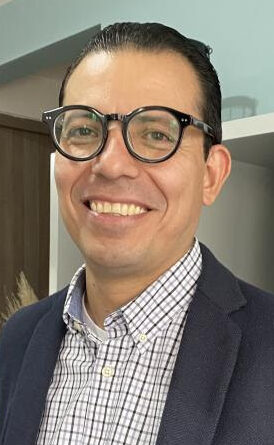 Eduardo Castillo (pictured) has been named the Associated Press’ news director for Latin America and the Caribbean, the news cooperative announced Monday. “Eduardo, 46, will be the first Latino to run the region as news director since the Latin America desk was established in 2005 . . . . Since 2020, Eduardo has been co-leading the region along with Bogota-based Deputy Director Ricardo Mazalan and Asuncion [Paraguay]-based Deputy Director Paul Byrne,” Paul Haven, vice president and head of global news gathering, told staff members. “He joined AP in 2003 and quickly established himself as one of the top Spanish-language correspondents in the region, a tireless reporter who asks the tough questions and an elegant writer bringing context to even the most complex stories. . . .”
Eduardo Castillo (pictured) has been named the Associated Press’ news director for Latin America and the Caribbean, the news cooperative announced Monday. “Eduardo, 46, will be the first Latino to run the region as news director since the Latin America desk was established in 2005 . . . . Since 2020, Eduardo has been co-leading the region along with Bogota-based Deputy Director Ricardo Mazalan and Asuncion [Paraguay]-based Deputy Director Paul Byrne,” Paul Haven, vice president and head of global news gathering, told staff members. “He joined AP in 2003 and quickly established himself as one of the top Spanish-language correspondents in the region, a tireless reporter who asks the tough questions and an elegant writer bringing context to even the most complex stories. . . .”

- The Texas House Committee that issued a report on the May 24 Uvalde school shooting provided “a report written in English, to a community that is more than 80% Hispanic or Latino, where half of residents age 5 or older speak a language other than English at home,” Nicole Carroll wrote July 22 for USA Today. “The Spanish-only speakers were left out. . . .” “Outrageous, said Manny García, editor of the Austin American-Statesman, part of the USA TODAY Network. Journalists at the Statesman and USA TODAY would translate and edit the entire report, all 77 pages, into Spanish and publish it as a special edition of the Statesman. . . . 10,000 papers on two pallets were delivered to Uvalde Thursday morning. García and others from the Statesman personally delivered copies to grocery stores, a pharmacy, restaurants, funeral homes, churches, the police department and library. . . .”
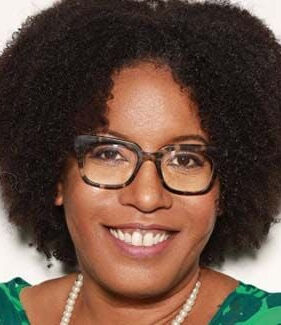 “Tanita Myers (pictured), VP/News Operations at iHeartMedia’s Black Information Network (BIN) has died at the age of 49,” Inside Radio reported July 13. “Myers was reportedly in New Orleans where she suffered a medical emergency and was rushed to Tulane Hospital, where she was admitted to ICU. She passed away on Wednesday, July 13. . . . Myers joined BIN as Director of News Operations when the network launched in June 2020. She spent the previous 15 years with Reach Media, serving as Director of Operations for ‘The Tom Joyner Morning Show;’ Executive Producer of ‘Rickey Smiley Morning Show’ and as news, traffic, and weather reporter at several major market stations. She was elevated to VP/News Operations in August of last year. . . .”
“Tanita Myers (pictured), VP/News Operations at iHeartMedia’s Black Information Network (BIN) has died at the age of 49,” Inside Radio reported July 13. “Myers was reportedly in New Orleans where she suffered a medical emergency and was rushed to Tulane Hospital, where she was admitted to ICU. She passed away on Wednesday, July 13. . . . Myers joined BIN as Director of News Operations when the network launched in June 2020. She spent the previous 15 years with Reach Media, serving as Director of Operations for ‘The Tom Joyner Morning Show;’ Executive Producer of ‘Rickey Smiley Morning Show’ and as news, traffic, and weather reporter at several major market stations. She was elevated to VP/News Operations in August of last year. . . .”
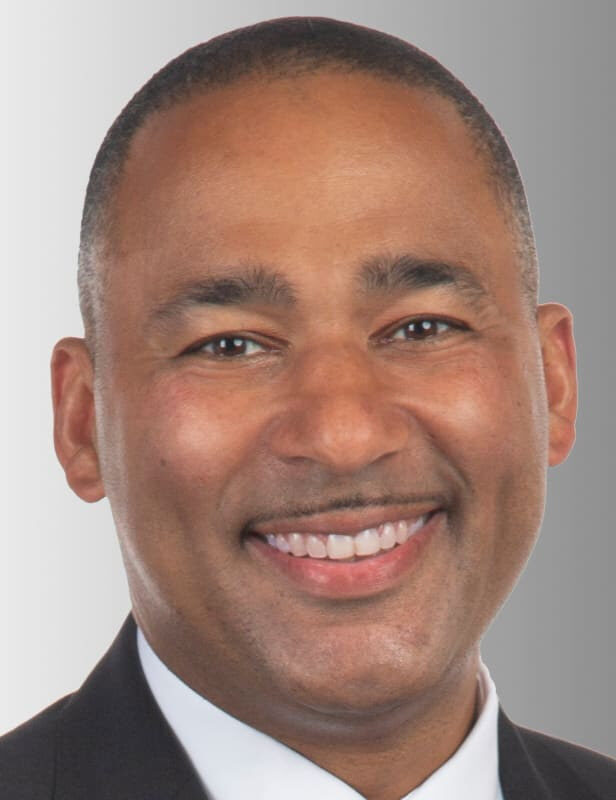 “Longtime WDIV meteorologist Andrew Humphrey has decided to leave the station after 20 years on the air to explore new opportunities,” the Detroit television station announced on Tuesday, Humphrey’s last day on its air. Kim Voet, WDIV news director, said in the announcement, “During the past 20 years, Andrew has happily greeted viewers with a big smile and helped them plan their weekends, and he seamlessly slid into any daypart to fill in and deliver the forecast. We’ve long heard from viewers about Andrew’s warmth, his great school visits with kids and his community involvement.” The announcement also said, “Humphrey is known as the ‘station scientist,’ and is the first and only broadcast meteorologist on the planet with a degree in meteorology from MIT.”
“Longtime WDIV meteorologist Andrew Humphrey has decided to leave the station after 20 years on the air to explore new opportunities,” the Detroit television station announced on Tuesday, Humphrey’s last day on its air. Kim Voet, WDIV news director, said in the announcement, “During the past 20 years, Andrew has happily greeted viewers with a big smile and helped them plan their weekends, and he seamlessly slid into any daypart to fill in and deliver the forecast. We’ve long heard from viewers about Andrew’s warmth, his great school visits with kids and his community involvement.” The announcement also said, “Humphrey is known as the ‘station scientist,’ and is the first and only broadcast meteorologist on the planet with a degree in meteorology from MIT.”
- The American Journalism Project announced $3.15 million in new support for three nonprofit news organizations: Verite, a sister newsroom of Mississippi Today launching this fall in New Orleans, ICT (formerly Indian Country Today) and New York City-based THE CITY, the project said July 20.
- The Radio Television Digital News Association calls our attention to Language, Please, a project established by Vox Media with funding from the Google News Initiative’s Innovation Challenge. The site calls itself “a living resource for all journalists and storytellers seeking to thoughtfully cover evolving social, cultural and identity related issues. “On this site, you will find style guidance spanning six main categories: borders and populations; class and social standing; disabilities, neurodiversity, and chronic illness; gender and sexuality; mental health, trauma, and substance use; and race and ethnicity. You will also find a directory of independent inclusivity readers who can be hired at any stage in a project and a set of reference tools to spark conversations and thoughtful decision-making around story framing and language usage. . . .”
-
 “BLCK Press is a collaborative newsroom dedicated to cultivating talented, diverse voices in the media industry. The publication works with ambitious journalists of color to challenge the status quo and give communities of color a platform to be heard,” Victoria Holmes reported Tuesday for Editor & Publisher. “Georgia Fort (pictured), the founder of BLCK Press, “knows the hurdles journalists of color face when trying to enter mainstream media newsrooms. Fort started as a broadcast journalist but could not move forward in her career when she tried applying for positions throughout the Twin Cities. Even with two Emmy nominations and 10 years of experience, Fort was denied career opportunities where she grew up. ‘If I wanted to keep doing it, I needed to create my own path, and I decided to do it independently,’ said Fort. . . .”
“BLCK Press is a collaborative newsroom dedicated to cultivating talented, diverse voices in the media industry. The publication works with ambitious journalists of color to challenge the status quo and give communities of color a platform to be heard,” Victoria Holmes reported Tuesday for Editor & Publisher. “Georgia Fort (pictured), the founder of BLCK Press, “knows the hurdles journalists of color face when trying to enter mainstream media newsrooms. Fort started as a broadcast journalist but could not move forward in her career when she tried applying for positions throughout the Twin Cities. Even with two Emmy nominations and 10 years of experience, Fort was denied career opportunities where she grew up. ‘If I wanted to keep doing it, I needed to create my own path, and I decided to do it independently,’ said Fort. . . .”
- The Black-owned Oklahoma Eagle, “in partnership with the University of Maryland Philip Merrill College of Journalism, the School of Journalism & Mass Communication, University of Wisconsin-Madison, and the On the Ground Reporting’ project,” is instructing participating journalism students “through the process of publishing stories that focus on community groups in Tulsa, Oklahoma. The class was led by Maryland associate professor and Washington Post staff writer DeNeen Brown, an Oklahoma native, who teamed with Eagle editors M. David Goodwin and Gary Lee.“
- In a candid interview with colleague Doreen Gentzler of Washington’s WRC-TV, “anchor Leon Harris opens up about his journey with sobriety and serving jail time after being convicted of driving under the influence,” the station said. “I will try to show you that I just, I deserve a shot at earning your trust and respect again. And the only way I can do that is through patterns, not promises,” Harris said.
- “The largely ignored history of how slavery shaped Brazil — and still does — is the centerpiece of a new podcast inspired by the New York Times’ 1619 Project,” Marina E. Franco of Noticias Telemundo wrote Thursday for Axios. Franco also wrote, the legacy “echoes the impacts of systemic racism that Nikole Hannah-Jones explored in the 1619 Project three years ago. . . . The Projeto Querino podcast, coming out Aug. 6, is aimed at helping listeners ‘know and understand the real weight that racism and slavery had on the formation of Brazil, in all aspects,’ host Tiago Rogero tells Axios Latino. . . .”
- “RT, the Kremlin-backed TV network formerly called Russia Today, is setting up its first Africa bureau as President Vladimir Putin seeks to entrench support in a continent that’s largely refrained from criticizing his invasion of Ukraine,” Antony Sguazzin reported Friday for Bloomberg News. “The company said in a response to a query that it’s ‘currently focused on developing our English-language Africa hub in South Africa,’ which will be headed up by Paula Slier, a South African broadcaster who ran RT’s Jerusalem bureau. . . .”
 “From a distance, and on paper, Ghana (flag at left) is a thriving democracy in a region beset with political and social turmoil,” Emmuanuel K. Dogbevi wrote July 19 for Nieman Reports. A Knight-Bagehot Fellow in Business and Economic Journalism at Columbia University, Dogbevi also wrote, “But on the ground, and in reality, journalists do not have the freedom to do their work, nor do they have free access to information. Government institutions often go to court to resist freedom of information requests by journalists. They also face risks of arrest, detention, and torture from state agencies like the police, military, secret service, and political operatives of ruling parties. The attacks have been systematic, and in nearly all cases, no one has been held to account . . . .”
“From a distance, and on paper, Ghana (flag at left) is a thriving democracy in a region beset with political and social turmoil,” Emmuanuel K. Dogbevi wrote July 19 for Nieman Reports. A Knight-Bagehot Fellow in Business and Economic Journalism at Columbia University, Dogbevi also wrote, “But on the ground, and in reality, journalists do not have the freedom to do their work, nor do they have free access to information. Government institutions often go to court to resist freedom of information requests by journalists. They also face risks of arrest, detention, and torture from state agencies like the police, military, secret service, and political operatives of ruling parties. The attacks have been systematic, and in nearly all cases, no one has been held to account . . . .”
- “Media in Pakistan cannot say they are inclusive when very few marginalized [community] members hold decision-making positions, reads a subhead over a July 20 story by Ole Tangen Jr. on the website of the German media organization Deutsche Welle. “DW Akademie is working to foster diversity and constructive journalism in the media landscape.” The story says, “According to Asif Khan, DW Akademie’s country representative for Pakistan, when a newsroom is not diverse, entire communities can be missing from TV screens and radio airwaves. . . . False and stereotypical reporting also frequently affects Pakistan’s underrepresented groups, such as women, religious minorities, transgender people or the disabled. Often, this reporting leads to hate speech, especially on social media. . . .”
-
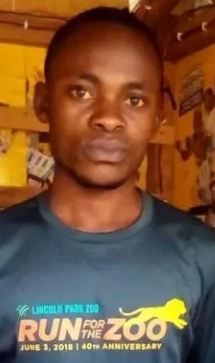 In Congo, “On the morning July 5, a group of six soldiers with the M23 rebel group detained Henry Hererimana Serushago (pictured), a reporter at La Voix de Mikeno (RACOM) community radio broadcaster, according to the journalist,” who spoke to the Committee to Protect Journalists in a phone interview, and a report by Journaliste en Danger, a local press freedom group, CPJ reported Friday. An M23 colonel “ordered Serushago to be detained, and soldiers forced him to the ground, tied him up, and whipped, kicked, and beat him, he said. The colonel threatened to kill Serushago if he spoke publicly about his mistreatment, saying he knew the location of his home, Serushago told CPJ. The rebels released him after about seven hours in custody, and he received treatment for injuries to his right leg and chest at a local hospital, he said. . . . Serushago was attempting to enter Uganda to conduct interviews with Congolese people who had fled the fighting in the eastern DRC, where M23 rebels recently seized control of several villages, he told CPJ. The press freedom group said his previous interviews with people displaced by the conflict included their denunciations of the M23.
In Congo, “On the morning July 5, a group of six soldiers with the M23 rebel group detained Henry Hererimana Serushago (pictured), a reporter at La Voix de Mikeno (RACOM) community radio broadcaster, according to the journalist,” who spoke to the Committee to Protect Journalists in a phone interview, and a report by Journaliste en Danger, a local press freedom group, CPJ reported Friday. An M23 colonel “ordered Serushago to be detained, and soldiers forced him to the ground, tied him up, and whipped, kicked, and beat him, he said. The colonel threatened to kill Serushago if he spoke publicly about his mistreatment, saying he knew the location of his home, Serushago told CPJ. The rebels released him after about seven hours in custody, and he received treatment for injuries to his right leg and chest at a local hospital, he said. . . . Serushago was attempting to enter Uganda to conduct interviews with Congolese people who had fled the fighting in the eastern DRC, where M23 rebels recently seized control of several villages, he told CPJ. The press freedom group said his previous interviews with people displaced by the conflict included their denunciations of the M23.To subscribe at no cost, please send an email to journal-isms+subscribe@groups.io and say who you are.
Facebook users: “Like” “Richard Prince’s Journal-isms” on Facebook.
Follow Richard Prince on Twitter @princeeditor
Richard Prince’s Journal-isms originates from Washington. It began in print before most of us knew what the internet was, and it would like to be referred to as a “column.” Any views expressed in the column are those of the person or organization quoted and not those of any other entity. Send tips, comments and concerns to Richard Prince at journal-isms+owner@
groups.io View previous columns (after Feb. 13, 2016).
View previous columns (before Feb. 13, 2016)
- Diversity’s Greatest Hits, 2018 (Jan. 4, 2019)
- Book Notes: Is Taking a Knee Really All That? (Dec. 20, 2018)
- Book Notes: Challenging ’45’ and Proudly Telling the Story (Dec. 18, 2018)
- Book Notes: Get Down With the Legends! (Dec. 11, 2018)
- Journalist Richard Prince w/Joe Madison (Sirius XM, April 18, 2018) (podcast)
- Richard Prince (journalist) (Wikipedia entry)
- February 2018 Podcast: Richard “Dick” Prince on the need for newsroom diversity (Gabriel Greschler, Student Press Law Center, Feb. 26, 2018)
- Diversity’s Greatest Hits, 2017 — Where Will They Take Us in the Year Ahead?
- Book Notes: Best Sellers, Uncovered Treasures, Overlooked History (Dec. 19, 2017)
- An advocate for diversity in the media is still pressing for representation, (Courtland Milloy, Washington Post, Nov. 28, 2017)
- Morgan Global Journalism Review: Journal-isms Journeys On (Aug. 31, 2017)
- Diversity’s Greatest Hits, 2016
- Book Notes: 16 Writers Dish About ‘Chelle,’ the First Lady
- Book Notes: From Coretta to Barack, and in Search of the Godfather
- Journal-isms’ Richard Prince Wants Your Ideas (FishbowlDC, Feb. 26, 2016)
- “JOURNAL-ISMS” IS LATEST TO BEAR BRUNT OF INDUSTRY’S ECONOMIC WOES (Feb. 19, 2016)
- Richard Prince with Charlayne Hunter-Gault, “PBS NewsHour,” “What stagnant diversity means for America’s newsrooms” (Dec. 15, 2015)
- Book Notes: Journalists Follow Their Passions
- Book Notes: Journalists Who Rocked Their World
- Book Notes: Hands Up! Read This!
- Book Notes: New Cosby Bio Looks Like a Best-Seller
- Journo-diversity advocate turns attention to Ezra Klein project (Erik Wemple, Washington Post, March 5, 2014)
When you shop @AmazonSmile, Amazon will make a donation to Journal-Isms Inc. https://t.co/OFkE3Gu0eK
— Richard Prince (@princeeditor) March 16, 2018
Page views: 599 at 12:23 p.m. July 30

